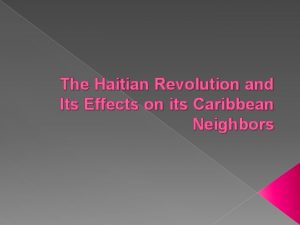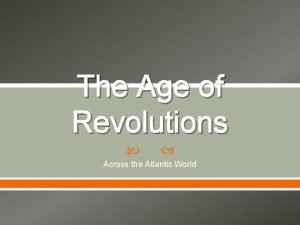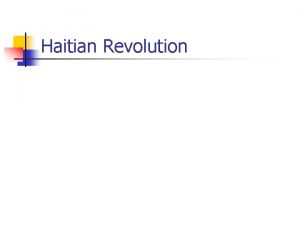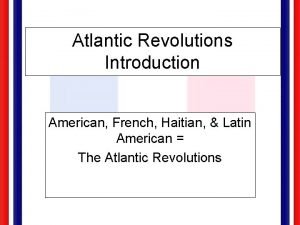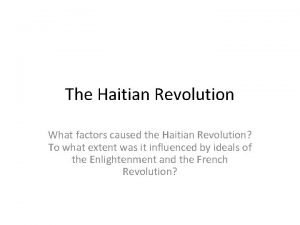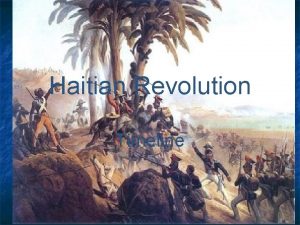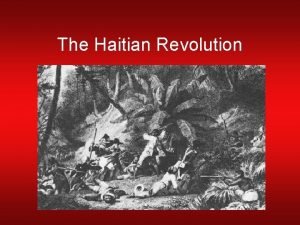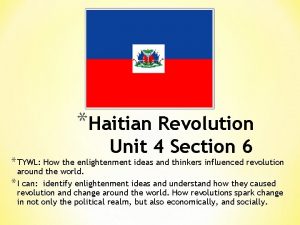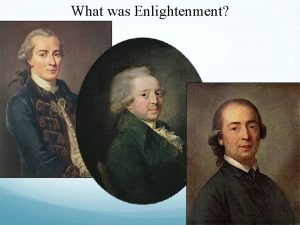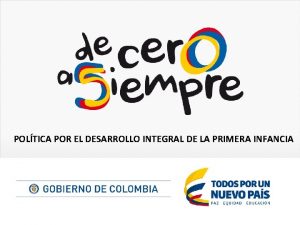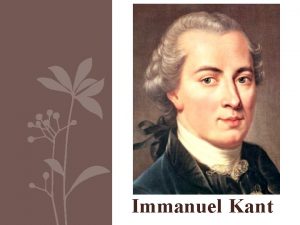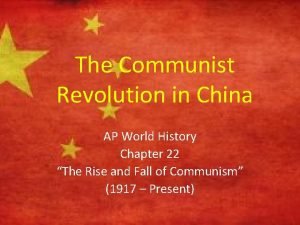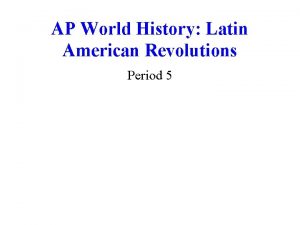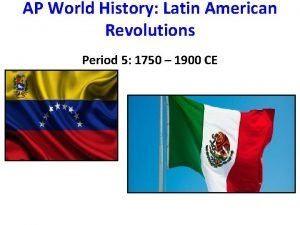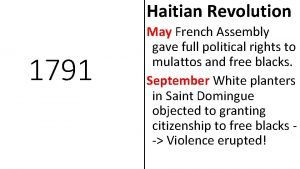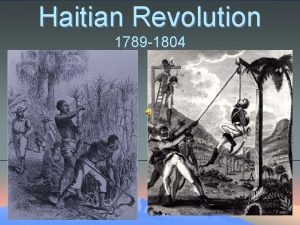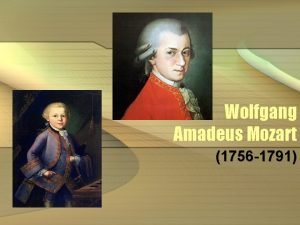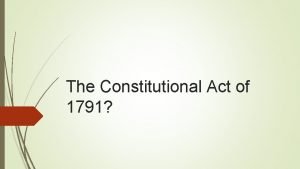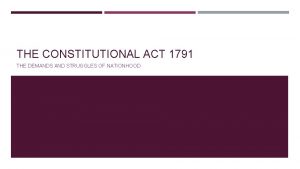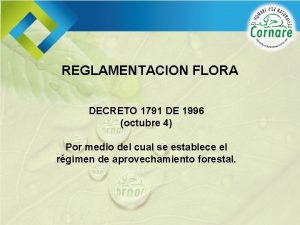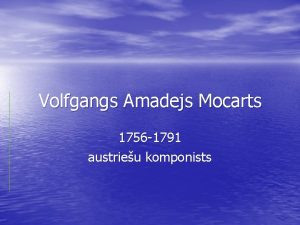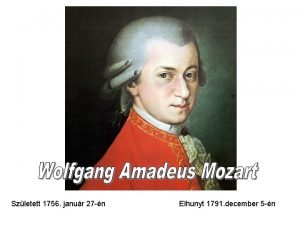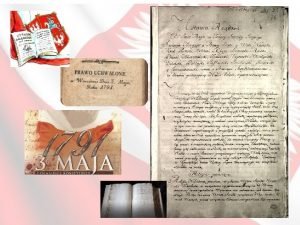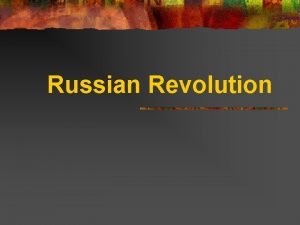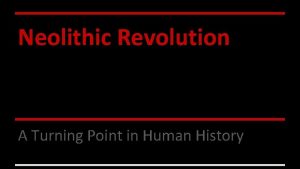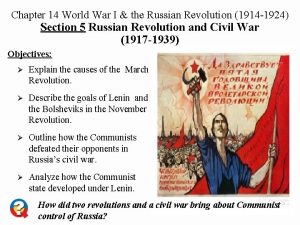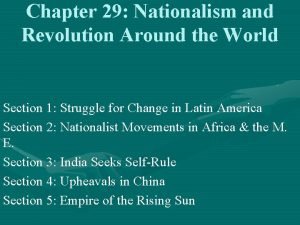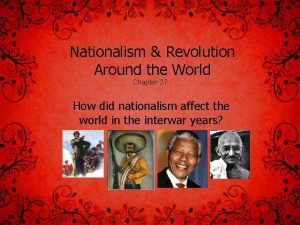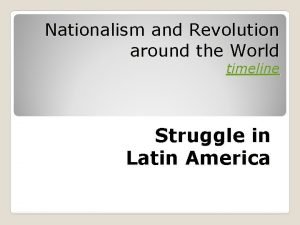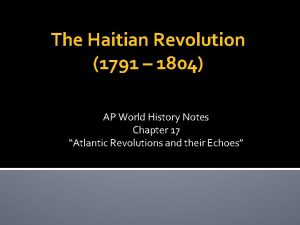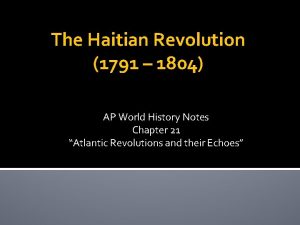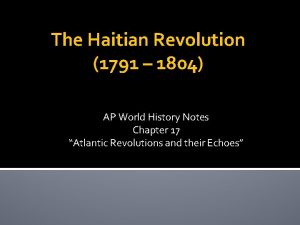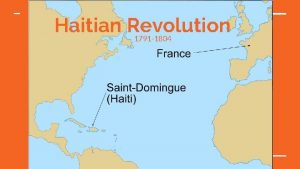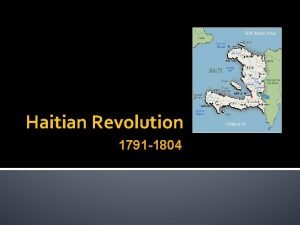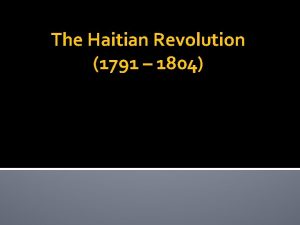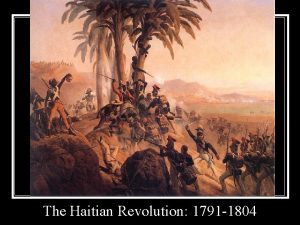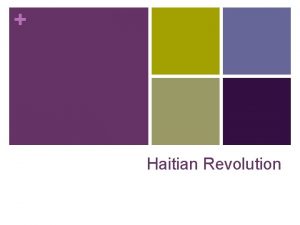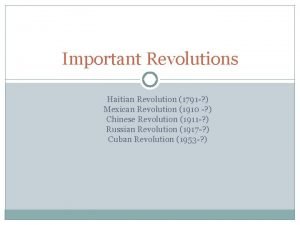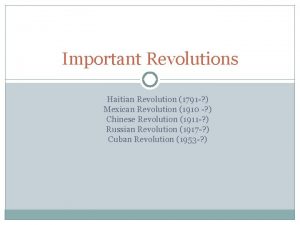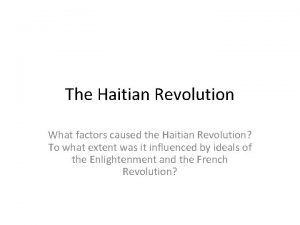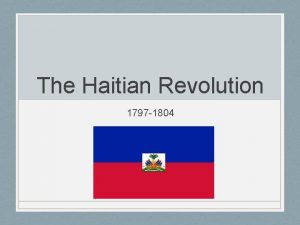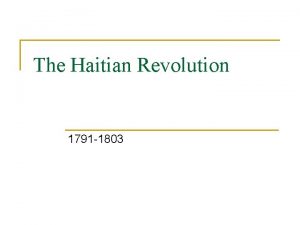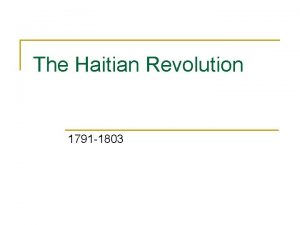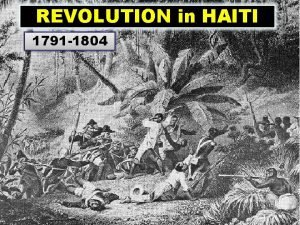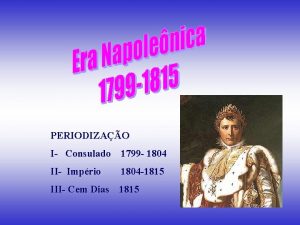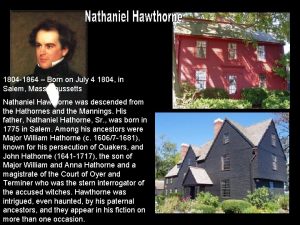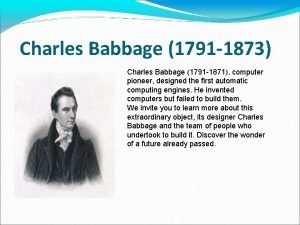The Haitian Revolution 1791 1804 AP World History














































- Slides: 46

The Haitian Revolution (1791 – 1804) AP World History Notes Chapter 17 “Atlantic Revolutions and their Echoes”

The Haitian Revolution - Mulattoes in Haïti possess limited freedom. - Mulattoes were required to enlist for a mandatory three-year term in the military establishment known as the marechaussée. *gave them military training* - They were then forced to serve in their local militia without compensation *gave them organization* a*required to provide their own supplies* - Mulattoes were angered by the fact that they were outlawed from holding office and were totally excluded from Haitian society. (could hold land but govt. restraints disabled them from really doing anything with it) Lead them to begin plotting revenge/an uprising as retribution to the way the whites treated them. *waited for right moment*

Results �Successes: Socially: • Slaves had freedom ▪ Whites fled or were killed Politically: ▪ Independent country ▪ Second independent republic in the Americas ▪ Napoleon unable to control over Haiti -> did not have the money to keep up with Louisiana (French territory) -> sold it to the American government Economically: ▪ No longer a country based on a plantation system ▪ Became small-scale farmers Racial divides and sectional politics ended the idealism of the Revolutionary period

Timeline � 1789 Saint Domingue (Haiti): First revolts (led by whites, mulattos) � 1790 Saint Domingue: “Night of Fire”—well-organized slave revolt � 1791 France: National Assembly declares full civil rights for mulattos (free men of color) –Slaves still revolt � 1792 Saint Domingue: Commissioner Sonthonax grants freedom to slaves in the North Province who fought for the French Republic, then orders general abolition � 1793 France: National Assembly extended freedom to slaves in all its colonies in the Emancipation Decree of 1794. Saint Domingue: Toussaint l’Ouverture leaves alliance with British & Spanish to help France drive them from the island � 1799 France: Napoleon Bonaparte seizes power Saint Domingue: British expelled from Saint-Domingue

Timeline � 1801 France: Napoleon dispatches General Leclerc to subdue Haiti � 1802 France : Reestablishment of slavery (May), Bonaparte named Consul for life -Saint Domingue: Death of Le. Clerc (November) � 1803 Saint Domingue: General Dessalines proclaims independence of Haiti (August 29) -France/U. S. : Signature of treaty of purchase, Louisiana Territory � 1804 France: Implementation of the Civil Code; declaration of empire (Dessalines declared independence and renamed the Island Haiti)

Declarations Bellwork �Which two Enlightenment thinkers do you feel had the greatest impact on the American and French Revolution? �Opinion �What would you say was the GREATEST similarity in idea between the Declaration of Independence and Declaration of Rights of Man? �Opinion �But probably power is derived from the people

French Revolution Bellwork �What action by King Louis and Marie lead to the creation of the French Republic? �They tried to leave France/Paris �What group ruled France during the Reign of Terror? �The Committee of/for Public Safety

Objective �WWBAT: Discuss the causes and impacts of the Haitian Revolution �WWBAT: Introduce the similar causes of the revolutions in Latin American colonies

Interactive Notebook Setup �Haitian and Latin American Revolutions � 4/1/2016 �This will be two pages

Haitian Revolution Background Haitian Revolution Latin American Revs Background

Brazilian Independence Mexican Independence Simón Bolívar Gran Colombia Successes & Failures

Haitian Revolution Background � Was originally called Saint Domingue by the French � French colony in the Caribbean � Colony’s purpose = plantations Richest colony in the world at the time 8, 000 plantations Produced 40% of the world’s sugar Produced 50% of the world’s coffee

Haitian Revolution Background � 500, 000 of the 570, 000 people living in the colony were slaves �There were also 30, 000 free people of color �Majority were small landowners

Haitian Revolution Background Slaves in Haiti suffered under some of the harshest treatments found in the Caribbean - So many died from harsh conditions that 40, 000 new slaves needed to brought a year - Slaves in Haiti were legally considered to be property of the public - This treatment evoked an often resentful and disobedient demeanor among the slaves -

Haitian Revolution Background �White population was quite divided � 40, 000 white people in the colony � Divided into two groups: “Grands blancs” = wealthy plantation owners, merchants, and lawyers “Petits blancs” = poor whites

Haitian Revolution Background � All of these social groups were inspired by the French Revolution � For “grands blancs” meant greater independence for the colony from France and fewer trade restrictions � For “petits blancs” meant equality of citizenship and economic opportunities � For free people of color meant equal rights and treatment for all free people, regardless of race � For slaves meant personal freedom

The Haitian Revolution �Earliest revolts were lead by mulattoes and “petit blancs” �These groups were seeking greater rights and more economic opportunities �The chaos lead to the eventual slave uprising that would define the Haitian Revolution

The Haitian Revolution �First slave revolt took place in 1790 �Triggered by rumors that the French king had declared an end to slavery �Slaves burned around 1, 000 plantations and killed hundred of white and mixed-race people

The Haitian Revolution �First revolt was followed colony wide salve revolt �As the revolution continued, power gravitated toward the slaves � Leader became a former slave named Toussaint Louverture


Toussaint Louverture(Revolution) Son of an educated slave Inspired by Enlightenment ideas and French Rev. Very inspirational and charismatic He formed his own army, inspiring hundreds to join him and displayed an impressive talent for designing and leading militaristic strategies and tactics that would enable him to make the slave insurgency one of the most successful in history. - Achieved aid from the Spanish and actually became an officer in the Spanish Military then when the slave were emancipated switched allegiance to French -

The Haitian Revolution �Only completely successful slave revolt in world history �Slaves became equal, free, and independent citizens almost immediately �Renamed area Haiti means “mountainous” or “rugged” in the language of the original inhabitants

The Haitian Revolution � Formal declaration of independence January 1, 1804 � Effects: Plantations destroyed Most whites fled or were killed Private and state lands redistributed among former slaves and free black people Haiti became a nation of small -scale farmers producing for their own needs A Celebration!

Latin American Revs Background �Inspired by the American, French, and Haitian Revolutions �Intellectuals had become familiar with ideas from the European Enlightenment

Latin American Revs Background Complaints of people in Latin America: Trade restrictions meant could only trade with the “motherland” ▪ Greatly limited economic possibilities High taxes they had to pay ▪ Spain had a 20% tax on most its colonies Rigid colonial social structure that limited rights and privileges for many people

Latin American Society � 30, 000 peninsulares, colonial officials from Iberian peninsula � 3. 5 million criollos (creoles), born in the Americas of Spanish or Portuguese descent Privileged class, but grievances with peninsulares 1810 -1825 led movements for creole-dominated republics � 10 million others African slaves, mixed-race populations 26

Latin American Revs Background � Latin Americans took action and started working toward independence when Napoleon invaded Spain and Portugal in 1808 Royal authority in disarray NOW would be the time to gain independence Almost every Spanish American colony had achieved independence by 1826

Latin American Revs Background � The struggle for Latin American independence was lengthy because these societies were so conflicted and divided by class, race, and region � Internal violent conflict often broke out as they were trying to fight against Spanish rule simultaneously Example: Creole elites versus peasants

Revolution Bellwork �What was the largest group on the French colony of San Domingue? �Slaves �The Haitian Revolution is the only_____________ in history �Completely Successful slave rebellion �Why did it take a long time for Latin American Independence movements to be organized? �Society was incredibly divided

Objective �WWBAT: Introduce and discuss the Mexican and Brazilian Independence Movements �WWBAT: Gather information about the South American Independence Movements and the successes and failures

Latin American Revs Background � It took the Spanish American colonies much longer to mobilize and move toward revolution than the colonies of North America Had little tradition of self- government Societies much more authoritarian and divided by class

Mexican Independence � Starting in 1810 Priests Miguel Hidalgo and Jose Morelos led the fight against Spanish rule in Mexico �Led a peasant insurrection � Believed revolt was the only way to achieve their 2 goals for Mexico: 1. Political freedom 2. End of slavery & improved living conditions for Mexico’s poor


Mexican Independence �An alliance of Church leaders and Creole elites raised an army and stopped this “radical” peasant rebellion They brought Mexico to a more controlled independence

Mexican Independence � 1821 Mexico declared its independence � Creole general Augustin de Iturbide (1783 -1824) declares independence in 1821 Installs self as Emperor, deposed in 1823 � 1823 Mexico became a republic

Brazilian Independence �Brazil’s quest for and achievement of independence is different than the rest of Latin America �It is different for one major reason… �…Brazil was a Portuguese colony

Brazilian Independence � 1807 Napoleon’s forces invaded Portugal largely to tighten the European blockade of Great Britain �Future king of Portugal, Prince Regent Dom João VI of Portugal decided to move the Portuguese Monarchy to their colony of Brazil �He, his family, and 10, 000 others moved from Portugal to Brazil

Dom Joao VI of Portugal

Brazilian Independence �Dom João VI implemented multiple popular policies and changes upon his arrival in Brazil �He canceled mercantile policies and opened Brazilian ports to allies �He also moved the capital of the Portuguese Kingdom to Rio de Janeiro �Manufacturing, a printing industry, and a major art scene developed after the arrival of the royal family

Brazilian Independence �Many in Portugal were upset by the policies of Dom João VI, feeling they favored Brazil over Portugal �There were also groups in both Portugal and Brazil that opposed the Absolute Monarchy of the Royal Family �There were calls a constitutional monarchy in the Portuguese Empire

Brazilian Independence �In 1815 Dom Joao elevated Brazil to a status of Kingdom, making it equal to Portugal �This meant that Brazilians could be elected to the parliament in Portugal, known as the Cortes

Brazilian Independence � After the end of the Napoleonic Wars the Cortes requested the Dom Joao return to Portugal � In 1816 Dom João VI was crowned King as his mother died � Joao only agreed to return when a revolt attempting to end his absolute monarchy broke out in 1820

Brazilian Independence �King Joao left his son Dom Pedro in charge of Brazil �The now more powerful Cortes began passing laws hostile towards Brazil, and even returned its status to that of a colony

Brazilian Independence �The Cortes asked Dom Pedro to return to Portugal �Dom Pedro refused and Portugal sent troops to bring him back �Dom Pedro’s forces meet them, but the Portuguese surrendered �All this happened while Brazilians Creoles in the Cortes called for independence

Brazilian Independence �In 1824 Dom Pedro made the Cry of Ipiranga: “by the blood that flows in my veins and upon my honour, I swear to God to free Brazil!” �In 1824 Pedro was crowned Emperor of Brazil �By 1825 the U. S. , Portugal, and Great Britain had all recognized Brazil as an independent country

Spanish South America � Leaders of the South American independence movement against Spain = Simon Bolivar & Jose de San Martin � Bolivar’s nickname = “the Liberator” � Started revolts in 1810 by 1826: they had liberated all of South America
 Cause of haitian revolution
Cause of haitian revolution Effects of the haitian revolution
Effects of the haitian revolution Impacts of the haitian revolution
Impacts of the haitian revolution Haitian
Haitian Haitian revolution causes
Haitian revolution causes What factors caused the haitian revolution
What factors caused the haitian revolution Haitian revolution timeline
Haitian revolution timeline Haitian revolution map
Haitian revolution map Causes of haitian revolution
Causes of haitian revolution Who is this
Who is this Da form 3328
Da form 3328 Knigsberg
Knigsberg Immanuel kant 1724 1804
Immanuel kant 1724 1804 Political risk examples
Political risk examples Mapa conceptual de la ley 1804 de 2016
Mapa conceptual de la ley 1804 de 2016 Biografia de kant
Biografia de kant Scientific revolution ap world history
Scientific revolution ap world history Communism in china ap world history
Communism in china ap world history Chinese communist party ap world history
Chinese communist party ap world history Industrialization definition ap world history
Industrialization definition ap world history Russian revolution of 1905 definition ap world history
Russian revolution of 1905 definition ap world history Jose de san martin ap world history
Jose de san martin ap world history Ap photo
Ap photo Haitian creole is an example of patois because
Haitian creole is an example of patois because Haitian
Haitian Haitian
Haitian Wolfgang amadeus mozart 1756-1791
Wolfgang amadeus mozart 1756-1791 Constitutional act of 1791
Constitutional act of 1791 Constitutional act of 1791
Constitutional act of 1791 Wolfgang amadeus mozart 1756 1791
Wolfgang amadeus mozart 1756 1791 Decreto 1791 del 4 de octubre de 1996
Decreto 1791 del 4 de octubre de 1996 Monarchie constitutionnelle 1791
Monarchie constitutionnelle 1791 Volfgangs amadejs mocarts
Volfgangs amadejs mocarts 1756-1791
1756-1791 Adam stanisław krasiński konstytucja 3 maja
Adam stanisław krasiński konstytucja 3 maja Ap world history chapter 25 africa and the atlantic world
Ap world history chapter 25 africa and the atlantic world History world tour
History world tour Russian revolution vs french revolution
Russian revolution vs french revolution Did american revolution cause french revolution
Did american revolution cause french revolution Third agricultural revolution definition
Third agricultural revolution definition Http://www.history.com/topics/russian-revolution
Http://www.history.com/topics/russian-revolution Why is the neolithic revolution a turning point in history
Why is the neolithic revolution a turning point in history Chapter 27 world war 1 and the russian revolution
Chapter 27 world war 1 and the russian revolution Kzbho6asboc -site:youtube.com
Kzbho6asboc -site:youtube.com Chapter 29: nationalism around the world answers
Chapter 29: nationalism around the world answers Nationalism and revolution around the world
Nationalism and revolution around the world Nationalism and revolution around the world
Nationalism and revolution around the world

